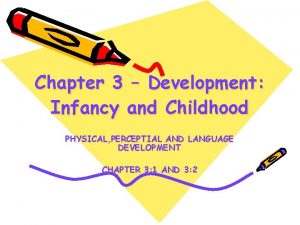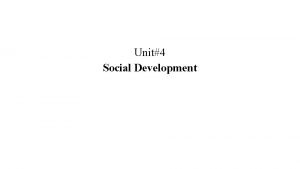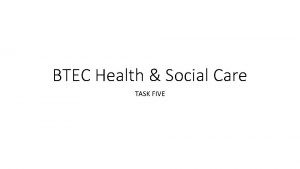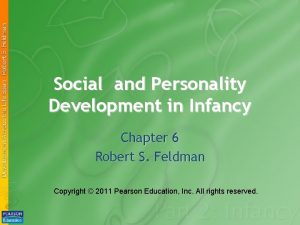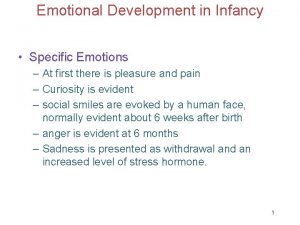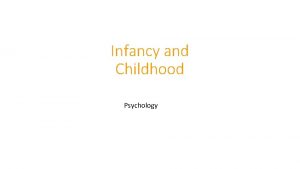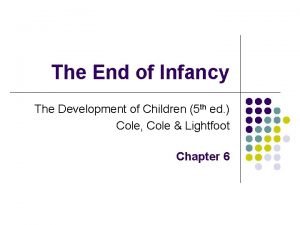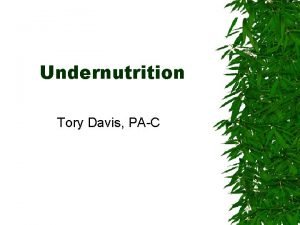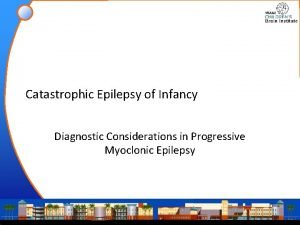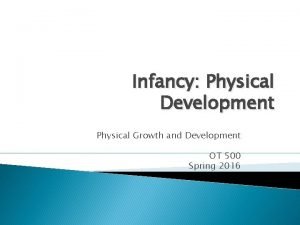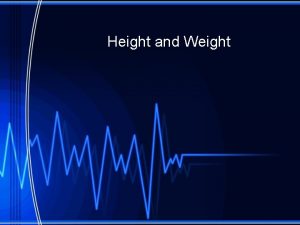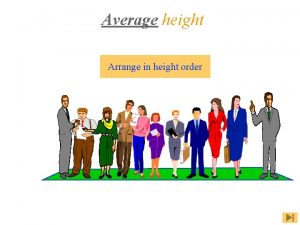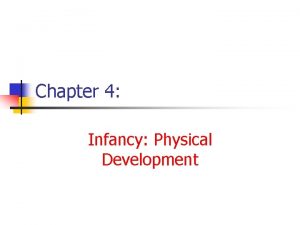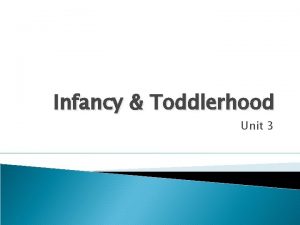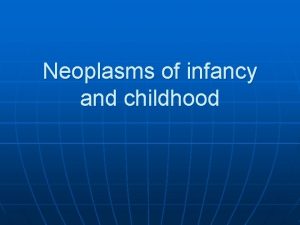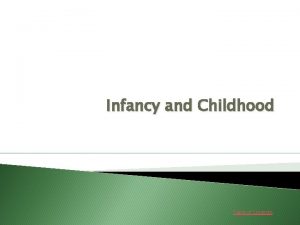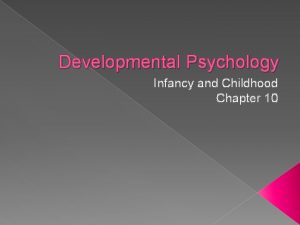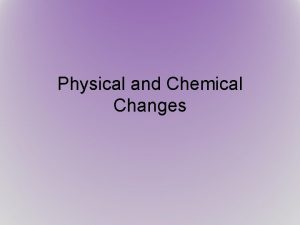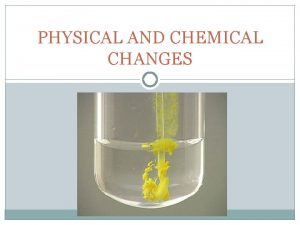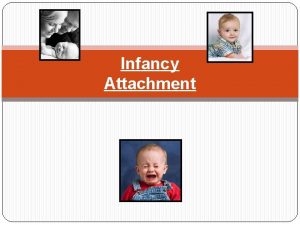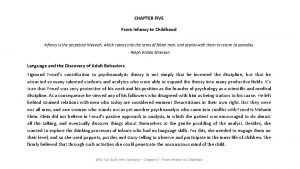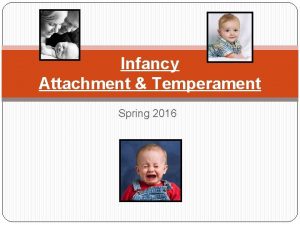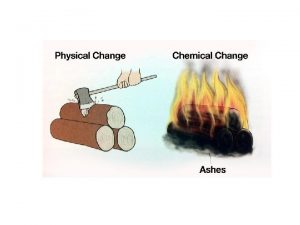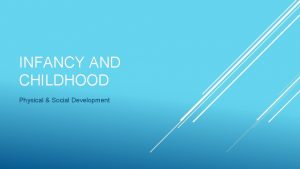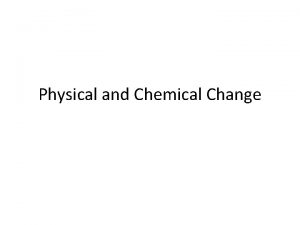Infancy Physical Development Growth and Change Height and






































- Slides: 38

Infancy

Physical Development: Growth and Change Height and Weight : • Infants grow at faster rate first year than at any other time • Weight doubles in first 5 months and triples by end of first year • Babies appear plump – Will lose baby fat in first year – Height is more uneven in growth than weight

Growth and Change Developmental Pattern Two key growth patterns Cephalocaudal principle –(head to tail) growth begins with the head and then downward to the rest of the body Proximodistal principle – growth proceeds from the middle of the body outword

Teeth and Teething • First tooth appears between 5 -9 months • Teething-first teeth break through skin – Symptoms include: • • Saliva production Coughing Rash Grabbing things to put in mouth • Relief can be found in teething ring or cold wet washcloth

Brain Development There about 100 -200 billion brain cells, or neurons, in the average infant brain Neurons release chemicals called neurotransmitters The axon of the neuron releases neurotransmitters and the dendrites receive them At birth, brain is ¼ the size of adult’s brain By age 2 it will be 70% of adult size

• Growth in brain due to – Exuberance-dendritic connections multiply – Myelination-axons become covered in a myelin sheath that increases the speed of communication between neurons • Synaptic pruning increases efficiency of dendritic connections

Brain divided into three major regions Hindbrain Midbrain Both structures mature early and perform basic biological functions (heart beating, lungs breathing and bodily movements balanced Forebrain Limbic system-hypothalamus, hippocampus (regulating hunger, thirst, body temperature, sexual desire)

• Cerebral Cortex - the ability to speak and understanding language, solve problems, think in terms of concepts and ideas • It is divided into left and right hemispheres: Left hemisphere is specialized for language and processing information Right hemisphere is specialized for spatial reasoning, logic

Sleep Changes Neonates sleep 16 -17 hours 3 -4 Months sleep 6 -7 hours at night Early infancy is highest risk period for Sudden Infant Death Syndrome (SIDS) Leading cause of death for infants 1 -12 months in developed countries • Poorer prenatal care could be a factor

Sudden Infant Death Syndrome • Risk factors: – Sleeping on stomach instead of back – Low birth weight and APGAR score – Smoking – Soft bedding • Campaign to reduce SIDS includes a Back to sleep campaign • Campaign has caused reduction of SIDS worldwide

Co-Sleeping: • Authorities in US warn against cosleeping – Why might this be? • Developing countries view it as normal – Believed to protect infants and to make breast feeding easier.

Nutritional Needs • Infants need a high fat diet which breast milk provides • About 6 months may introduce solid foods – Cultural variations in food introduced – West-rice cereal – Traditional cultures-mashed, prechewed, pureed

• Malnutrition during this time can be severe and lasting • Can be caused by inability of mother to breastfeed • Can cause marasmus- wasting away of body tissue due to lack of nutrients.

Infant Mortality Top sources of infant mortality include – Malnutrition – Malaria – Diarrhea • Vaccinations have been beneficial

Physical Development Motor and Sensory Development • Gross motor development includes whole body movements like crawling, walking, climbing… • Children tend to develop gross motor skills in sequence • Sequence has genetic beginnings with environmental influences


• Cultural practices emphasize the role of environment on gross motor skills • Swaddling is common practice which can be restrictive to infants • Other cultures encourage gross motor skills

Fine motor skills are the more precise motor abilities • Major accomplishments include reaching and grasping • By 9 -12 mos. , learn pincer grasp that allows feeding of themselves

Motor and Sensory Development Depth perception is influenced by development of binocular vision( the ability to combine the images of each eye into one image) at 2 -3 months of age Intermodal perception One-month-olds match things in mouth to things they touch By eight months can match unfamiliar faces with correct voice and gender. Intermodal perception helps infants learn about their physical and social world.

• http: //media. pearsoncmg. com/ph/hss_ar nett_humandevelopment_1/QRvideo/CH 4 Fin e. Motor. Skills. V 9. m 4 v (infant fine motor development across cultures)

Cognitive Development

Piaget’s Theory of Cognitive Development • Substage 1(0 -1 month): cognitive activity is based on Simple reflexes (sucking, rooting, grasping. These are type of scheme • Substage 2(1 -4 months): First habits & primary circular reactions (repetitive behavior – ex. sucking fingers)

• Substage 3 (4 -8 months): Secondary circular reactions – repeats behavior intentionally when finds cause and effect • Substage 4 (8 -12 months): Coordination of secondary schemes – goal directed actions (ex. moving object out of way to reach another object) • Sensorimotor Substages:

Object Permanence Under 4 months no understanding 4 -8 months-uncertainty about existence of object when dropped (babies look only briefly) 8 -12 months-Developing awareness Will still make A not B error https: //www. youtube. com/watch? v=lh. Hk. J 3 In. QOE http: //media. pearsoncmg. com/ph/hss_arnett_hum andevelopment_1/QRvideo/CH 4 Object. Permanence. V 2. m 4 v

Information Processing in Infancy • Information processing model views cognitive changes as continuous. • Human thinking divided into capacities for attention, processing and memory.

Attention • Attention studied using habituation and dishabituation • Habituation-gradual decrease in attention (example a toy that is presented over and over again. ) • Dishabituation-revival of attention with a new stimulus (Pay more attention to a new stimuli. )

• Infants become better at perceiving and processing stimuli • End of first year- joint attention highlights social attention (social interaction between infants and others)

Memory • Short Term memory improves during first year of life – Object permanence tasks show infants can remember more locations of hidden objects • Long Term memory increases as well • Difference between recognition memory and recall memory

Assessing Infant Development Arnold Gesell – four subscale assessment tool that assess infant development Motor skills Language Use Adaptive behavior Personal-Social behavior Development Quotient (DQ)

Nancy Bayley produced a contemporary measure of infant development • 3 main scales: – Cognitive – Language – Motor • Not predictive of later IQ, but can be used as a screening tool

Media Stimulation • Mozart” effect led to creation of educational videos and DVDs – Most studies have not supported the effectiveness of education CDs and videos • Effective ways to encourage cognitive interaction includes talking, reading, responding and patience

Language Development

• Many cultures use infant-directed speech to speak to infants – Higher Pitch with simplified grammar – Exaggerated intonation and phrases repeated • Infants seem to prefer this speech and is common in many cultures

Emotional and Social Development

Temperament Temperament-innate tendencies that are the raw material of personality Composed of activity level, adaptability, intensity of reactions and quality of mood Alexander Thomas and Stella Chess proposed classified temperaments as: Easy – positive, adapt easily to a new environment Difficult – negative mood, hard adaptation Slow to warm up – adaptation is slow Goodness-of-fit concept – children develop best if there is a good fit between the temperament of the child and environmental demands

Infant Emotions • Primary emotions are basic emotions we share with other animals. • Secondary emotions develop later and are called socio-moral emotions (embarrassment, shame and guilt) • Primary emotions- distress, interest and pleasure in first weeks of life – Becomes anger, sadness, fear, surprise and happiness

• Anger as being separate from crying occurs by 7 months of age • Sadness is rare unless mothers are depressed • Fear- by 6 months of age – Fear seems to occur with stranger anxiety • Surprise -about 6 months of age • Happiness-2 to 3 months

Social Development: Two Theories • Erikson – trust vs. mistrust • Bowlby’s Attachment Theory- believed if the primary caregiver is sensitive and responsive in caring for the infant, the infant will learn to trust others • http: //media. pearsoncmg. com/ph/hss_ar nett_humandevelopment_1/QRvideo/socialre ferencing. m 4 v
 Late childhood
Late childhood Internally programmed growth of a child
Internally programmed growth of a child Rovee-collier
Rovee-collier Social development in infancy
Social development in infancy Module 47 infancy and childhood cognitive development
Module 47 infancy and childhood cognitive development Intellectual meaning health and social
Intellectual meaning health and social Module 47 infancy and childhood cognitive development
Module 47 infancy and childhood cognitive development Chapter 5 cognitive development in infancy and toddlerhood
Chapter 5 cognitive development in infancy and toddlerhood Infancy physical changes
Infancy physical changes Socioemotional development in infancy
Socioemotional development in infancy Infancy psychosocial development
Infancy psychosocial development Slidetodoc.com
Slidetodoc.com Personality development in infancy
Personality development in infancy Personality development in infancy
Personality development in infancy New emotions that appear toward the second year
New emotions that appear toward the second year Growth and development in physical education
Growth and development in physical education Chemical change and physical change
Chemical change and physical change Differences between chemical and physical changes
Differences between chemical and physical changes Physical and chemical changes examples
Physical and chemical changes examples Whats the difference between physical and chemical changes
Whats the difference between physical and chemical changes Tvu of level crossing
Tvu of level crossing Is painting a wall a physical change
Is painting a wall a physical change Spare change physical versus chemical change
Spare change physical versus chemical change Physical change
Physical change Baking chemical change
Baking chemical change Is chopping a tree a chemical change
Is chopping a tree a chemical change Infancy and childhood psychology
Infancy and childhood psychology Chapter 10 infancy and childhood
Chapter 10 infancy and childhood Chapter 10 infancy and childhood
Chapter 10 infancy and childhood Chapter 10 infancy and childhood review worksheet answers
Chapter 10 infancy and childhood review worksheet answers Lesson quiz 3-2 infancy and childhood
Lesson quiz 3-2 infancy and childhood Growth analysis
Growth analysis Monocots vs eudicots
Monocots vs eudicots Primary growth and secondary growth in plants
Primary growth and secondary growth in plants Vascular ray
Vascular ray Infancy period
Infancy period Middle childhood age
Middle childhood age Infancy
Infancy Catastrophic epilepsy infancy
Catastrophic epilepsy infancy

